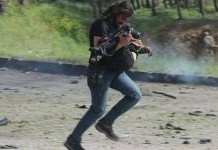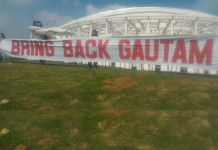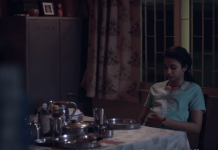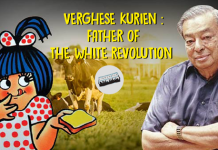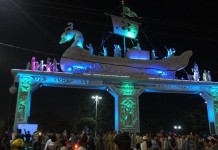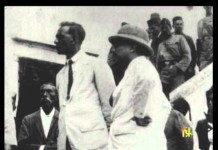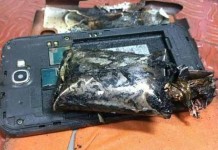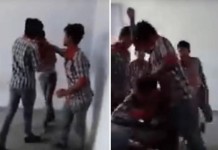Killing Veerappan is an upcoming film, directed by Ram Gopal Varma with Shivaraj Kumar, Sandeep Bharadwaj and Parul Yadav in lead roles, produced by BV Manjunath, music composed by Sai Kartheek, Ravi Shanker, background music and sound design by Seshu KMR. The film is based on the real story of Veerappan, the most dreaded and notorious bandit of Asia and a sandalwood smuggler who was active for years in the forest lands of about 6000 km, stretched in Karnataka, Kerala and Tamil Nadu.
Veerappan married Muthulakshmi and is said to have strangled one of their children soon after birth because she was their third successive girl. His wife reportedly appreciated his “notoriety and mustache” and married him because of that. As of 2004, his two daughters were studying in Tamil Nadu.
Veerappan started as an assistant to his relative Sevi Gounder, a notorious poacher and sandalwood smuggler. His father and relatives, whose village lay in the forest area, were also known to be poachers and smugglers. Veerappan began his career in crime in 1970 and was first arrested in 1972.
Veerappan initially developed as a sandalwood and ivory smuggler, killing elephants for the latter. He later started killing those who resisted his activities. He committed his first murder at the age of 17 and his victims tended to be police officers, forest officials and informants.
In 1987, Veerappan kidnapped and murdered a forest officer Chidambaram from Tamil Nadu. This brought him to the Union Government’s attention. Among his well-known killings are a senior IFS officer Pandillapalli Srinivas in November 1991, and an ambush of a police party including a senior IPS officer Harikrishna, among others, in August 1992.
Veerappan was not averse to killing civilians, and killed a man from his native village for having once travelled in a police jeep. He regularly killed anyone suspected of being a police informer. Because of political instability, Veerappan could easily escape from one state to another.
Palar blast:
In Govindapadi, Mettur, Veerappan killed a Bandari suspected of being a police informer, and a 41-member team of police and forest officials was called in. On 9 April 1993, a landmine was detonated against the two vehicles this team was travelling in. The blast occurred at Palar, near Malai Mahadeswara hills in today’s Chamarajanagar district of Karnataka, and killed 22. Known as Palar blast, this was his single largest mass killing.
Special Task Force:
In 1990, Karnataka and Tamil Nadu governments formed a Special Task Force to catch Veerappan. In February 1992, his lieutenant Gurunathan was killed by the Karnataka task force, with SI Shakeel Ahmed single-handedly responsible for the capture. Three months later, Veerappan attacked the Ramapura police station in Chamarajanagar and killed several policemen and looted arms and ammunition. In August 1992, Veerappan laid a trap for SI Shakeel Ahmed, killing him along with five others. The Karnataka and Tamil Nadu Special Task Forces then began intensified combing operations along the two states’ border areas and also around Gopinatham village, Veerappan’s birthplace.
Through these operations, the combined Special Task Force discovered that Veerappan’s gang was down to only five members. Meetings with Gopinatham villagers were held, and a bounty of Rs 5 crore was announced.
Kidnap of Rajkumar:
On 30 July 2000, Veerappan kidnapped a famous Kannada actor Rajkumar and three others from Dodda Gajanur, a village near the Tamil Nadu-Karnataka border where the film star was attending a housewarming ceremony. Public outcry and violence ensued in Bangalore as well as other parts of Karnataka. Karnataka’s Chief Minister and police personnel sought the help of Tamil Nadu government and visited Chennai seeking help. Negotiations were conducted and R. Gopal, editor of Tamil magazine Nakkeeran, was involved in several rounds of talks with Veerappan. Gopal had earlier visited Veerappan for similar negotiations, and the forest several times for videotaped discussions. Veerappan demanded justice for Tamil Nadu in the Cauvery Water dispute, as well as making Tamil the second official language of Karnataka and the release of certain Tamil extremists jailed in Tamil Nadu. Rajkumar was held for 109 days and finally released without harm in November 2000. A police official had reportedly suggested later that Rs 30 crore were paid for his release.
Kidnap of H Nagappa:
On 25 August 2002, Veerappan abducted H Nagappa, a former minister of Karnataka, from his village. He was a minister for Agricultural Marketing from 1996 to 1999. The Joint Special task forces of Karnataka and Tamil Nadu worked with Kerala Police to help release Nagappa but in vain. An encounter followed and Nagappa was found dead three months later in a Karnataka forest.
Ransom demands:
For several years in the 1990s, Veerappan kidnapped police officers and other personalities to demand ransom. It is believed that ransoms were often unofficially paid. In July 1997, he kidnapped nine forest officials in the Burude forests in Chamarajanagara district. In that case, the hostages were released unharmed a few weeks later even though his ransom demand was not met. It is also believed that Veerappan buried large amounts of money in various parts of the forest.
Political support:
During his later years, Veerappan got political support from Tamil nationalist organisations like PMK, a party predominantly of the Vanniyar caste to which Veerappan belonged. Former Chief Minister of Tamil Nadu M Karunanidhi of DMK was a known sympathiser of the smuggler and his aides, and demanded removal of death penalty to four of his aides in 2013. Karunanidhi also extended the 31 October 1997 deadline for Veerappan’s surrender and postponed Special Task Force (STF) police action by few days saying, “it is not far too late for Veerappan to surrender”. Banned organisations like TNRT and TNLA, a front in Tamil Nadu for LTTE, helped Veerappan to secure a Robin Hood image and draft terms of negotiations when he kidnapped prominent people. Kolathur Mani, president of DVK, formerly known as PDK, supported Veerappan and was booked by police as an accomplice in several of Veerappan’s crimes including the Palar blast case.
Death:
On 18 October 2004, Veerappan and two of his associates were killed by the Tamil Nadu Special Task Force headed by K Vijay Kumar. The killing happened near the village of Papparapatti in Dharmapuri district, Tamil Nadu. Veerappan and his men were lured into an ambulance by an undercover policeman under the pretext of taking them to Dharmapuri for medical treatment. The Tamil Nadu Special Task Force, which had been observing his movements for several months, surrounded the ambulance, and the gangsters were killed in the ensuing gun battle. The entire operation was named ‘Operation Cocoon’ and Veerappan’s associates Sethukuli Govindan, Chandre Gowdar and Sethumani were also killed in the operation. His death was described as the “death of a demon” by The Guardian. The villagers of Gopinatham, his birthplace, celebrated with firecrackers on hearing the news. Since Veerappan’s death, the village has been promoted as a destination for ecotourism by the Karnataka State Department of Forest and Tourism.
Veerappan was buried at a village named Moolakadu, Tamil Nadu, as his family members were more attached to it and most of his relatives in Gopinatham had left. The police had planned a cremation but decided on a burial after objections from Veerappan’s relatives. Thousands of people turned out for the burial, while others were kept away by heavy security.
For more updates on RGV and Killing Veerappan:
Like – https://www.facebook.com/RGV
Subscribe – https://www.youtube.com/rgv
Follow – https://twitter.com/RGVzoomin
Source: Wikipedia



